-
Paper Information
- Next Paper
- Paper Submission
-
Journal Information
- About This Journal
- Editorial Board
- Current Issue
- Archive
- Author Guidelines
- Contact Us
International Journal of Composite Materials
p-ISSN: 2166-479X e-ISSN: 2166-4919
2011; 1(1): 1-6
doi: 10.5923/j.cmaterials.20110101.01
Vibration Damping in Ni-Mn-Ga/PU Polymer Composites
Racil Jeya Geetha 1, 2, R. Senthur Pandi 1, S. Seenithurai 1, S. Vinodh Kumar 1, M. Muthuraman 1, J. Thampi Thanka Kumaran 2, M. Mahendran 1
1Smart Materials Lab, Department of Physics, Thiagarajar College of Engineering, Madurai, 625015, India
2Department of Physics, Nesamony Memorial Christian College, Marthandam, 629165, India
Correspondence to: M. Mahendran , Smart Materials Lab, Department of Physics, Thiagarajar College of Engineering, Madurai, 625015, India.
| Email: |  |
Copyright © 2012 Scientific & Academic Publishing. All Rights Reserved.
Ni-Mn-Ga ferromagnetic shape memory alloy is mainly focused from the class of active materials because of their large field induced strain. They exhibit strains up to 10% with respect to the applied magnetic field through twin boundary motion in the martensite phase. This is the main advantage of this material which could overcome the frequency bound of the conventional shape memory alloys. Ni-Mn-Ga FSMAs show much large field-induced strain at low frequencies than do other active materials such as piezoelectrics or magentostrictors. When the twin boundaries are moving back and forth, the hysteresis connected to this motion provides vibration damping part of the damping bases on the magnetoelastic properties of the materials. The excellent damping properties of Ni-Mn-Ga alloys are bonded with the correct polymer matrix makes possible to develop new damping materials which are effective, less expensive and easier to form than bulk Ni-Mn-Ga. They can suit well to be used in the correct site for effective damping in special engineering applications. In this article, we have prepared the composite materials and reported its basic characterization and the damping behavior of composite materials.
Keywords: Vibration Damping, Ni-Mn-Ga, FSMA Polymer Composites
Cite this paper: Racil Jeya Geetha , R. Senthur Pandi , S. Seenithurai , S. Vinodh Kumar , M. Muthuraman , J. Thampi Thanka Kumaran , M. Mahendran , "Vibration Damping in Ni-Mn-Ga/PU Polymer Composites", International Journal of Composite Materials, Vol. 1 No. 1, 2011, pp. 1-6. doi: 10.5923/j.cmaterials.20110101.01.
Article Outline
1. Introduction
- Ferromagnetic Shape Memory Alloys (FSMAs) are well known for their giant Magnetic-Field Induced Strain (MFIS), which makes them potential candidates for applications such as actuators and sensor[1,2]. Almost 10% of MFIS has been reported in martensitic Ni-Mn-Ga in 2002[1]. The FSMA differs from the conventional SMA by its twin boundary motion in the martensitic phase rather than the structural change[1-4]. The operating frequency of many conventional shape memory alloys is limited to some Hz whereas FSMA can be used in KHz. The strain recovery of these materials is due to the twin boundary movement, which is very different from the domain growth mechanism of magnetostrictive material. The maximum strain of this material is determined by its crystal structure[5]. The High positioning accuracy of Ni-Mn-Ga makes them as a promising candidate for potential applications[6]. Actuation and sensing nature of this material are limited by their brittleness. The advantages like high frequency performance and the large MFIS of Ni-Mn-Ga will be limited. In actuation applications, it needs acompressive loading to recover its original shape. The crystal form of this alloy cannot be used for cyclic actuators and dampers. So the brittleness should be overcome without affecting the strain output of this material. These disadvantages are partially overcome by embedding the Ni-Mn-Ga particle into the polymer matrix. There are several reports about the polymer matrix Ni-Mn-Ga composites by various research groups[7-15]. The polymer magnetic composite have many advantages such as light weight, low cost and design flexibilities. The polymer composites with aligned particles are expected as a better solution to resolve the brittleness behavior. The composite is significantly more flexible than the crystalline materials which allow cyclic compression and expansions. Ni-Mn-Ga reinforced polymer composites and their mechanical behavior are reported. The particles in the composite are respond to the mechanical stress with twin boundary motion. The proper alignment with magnetic curing leads to the particle interaction and twin boundary motion. Cyclic actuation, vibration damping, magnetization in polymer composites, twin boundary movement in polymer composites and stress- strain studies for energy absorption applications were already carried out[8-18]. In the present work, owing to the want of much needed scientific data on the Ni-Mn-Ga/PU composites, a new material having good mechanical damping has been designed and developed. The composite of this kind has been chosen, as it is useful in potential applications like vibration damping applications[7-18].
2. Experimental Procedure
2.1. Polycrystal Preparation
- The polycrystalline ingots are produced using the arc-melting furnace. The arc melting chamber is fleshed off with the pure argon for three to four time to remove the as much as air inside. While the melting process the chamber is completely filled with argon. It helps the arc to travel and reach the sample in the chamber. The raw materials of the systems are taken with high purity in the stoichiometric ratio. After the first melt, all the ingots are reverted in their same place and melted once again in the argon atmosphere. This melting procedure is repeated upto six times with replacing the ingots in all the dimensions. This multiple time melting procedure is done to achieve the homogeneity in the sample. Once the melt is completed the samples are taken out of the chamber and sealed in a quartz tube with argon atmosphere for thermal annealing. Thermal treatment for the phase transformation is done in the samples. The samples are kept in a box furnace with 1100° C for 10 days. After that quenching in the systems are done to stabilize the phase.
2.2. Composite Preparation
- For the composites preparation samples with similar sizes cut down from the crystals and crushed into powders. The crystals are changed in to particles using the ball milling process (Retsch PM100). The mortar grinding and spark eroded powder based composite are already reported. The milling process produces rigid solid particles unlike the hollow one in the spark erosion. The particle sizes are dependent on the milling time. The milled particles of the Ni-Mn-Ga are mixed with polymer resin completely. The magnetic particle and polymer mixture must be optimized. The polymer composites should be made in only martensite temperatures. So that, the twin boundaries in the particles are present and also the particles with easy axis alignment are possible due to their crystal structures.
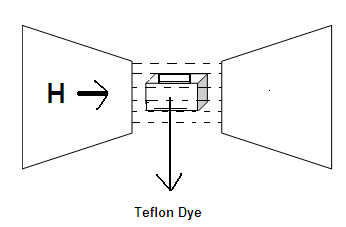 | Figure 1. Magnetic Curing of the Samples |
2.3. Damping Setup
- In the setup, the power supply is coupled with a function generator which acts as the input for the piezostack actuator. The actuator is in direct contact with sample, the input voltage with a particular frequency for which the actuator converts the signal into corresponding mechanical vibrations. These mechanical vibrations pass through the sample and transmitted signal is converted by the sensor to electrical signal. PZT ceramic sheet of 0.5 mm thickness is used as sensor. The longitudinal stress waves passed through the samples with different input peak to peak voltages (Vpp) are received by the PZT sensor. The voltage produced by sensor is picked up through a lock-in amplifier.
3. Results and Discussion
3.1. Structural Studies
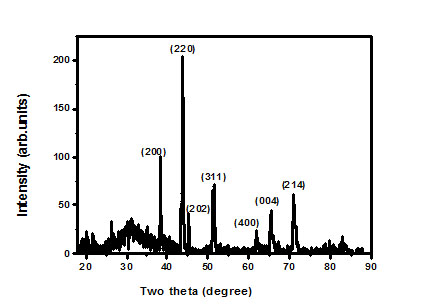 | Figure 2. Powder X-ray Diffraction Pattern of the Ni-Mn-Ga Polycrystal |
3.2. Micro-Structural Studies
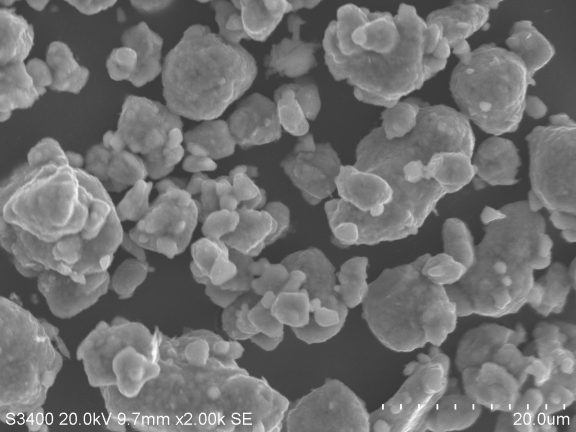 | Figure 3. SEM image of Ni-Mn-Ga Crystalline Powder |
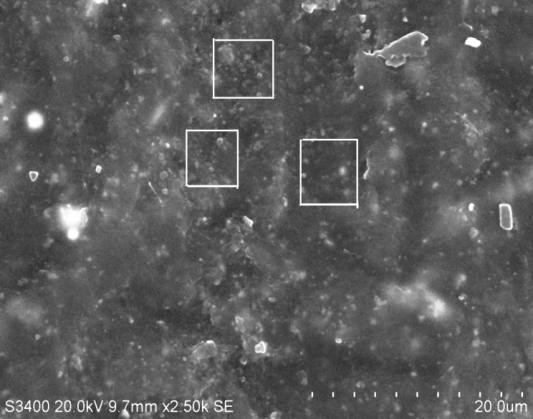 | Figure 4. SEM image of Ni-Mn-Ga/Polymer Composite |
3.3. Elemental Analysis using Scanning Electron Microscope
- Figure 5 a) and b) show the SEM images of the Ni-Mn-Ga/PU composites. The SEM pictures can be easily identified by the separate compound analysis images. The Ni content and the Carbon content of the polymer composite is identified in separate pictures. The elemental analysis is an evident one for the particle and matrix identification in the SEM pictures. The grey matrix ball like structures is the Ni-Mn-Ga particles present in the matrix. The glittered and most sprayed material is identified as polymer matrix. So, the alignment of the particles is not clearly viewed in the above picture. It confirms the particulate and matrix material.
3.4. Magnetic Studies
- The magnetic measurement is done in the Lakhshore 7404 Vibrating Sample Magnetometer (VSM). The magnetic hysteresis loops of the sample are shown in the figure 6. The hysteresis curve indicates the ferromagnetic nature of the polymer composites. The saturation magnetization is one of the important factors for the magnetic field induced strains. The saturation magnetization will reflect the ferromagnetic order. It can be evaluated by the magnetization curve. Figure 6 shows graph between the field versus magnetization of the composite samples. This hysteresis loop show magnetic behavior of the particles in the matrix material. The saturation magnetization is very low when comparing with the single crystals of this alloy. It is due to variation from the bulk materials to particle ones and their immersion in polymer matrix of the composites[19]. The particle ratio in the polymer is one of the important parameter for the magnetic behavior of these composites.
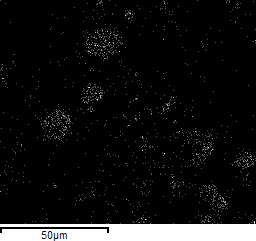 | Figure 5 a). Elemental Analysis studies using Scanning Electron Microscope (Ni content) |
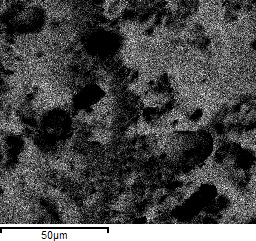 | Figure 5 b). Elemental Analysis studies using Scanning Electron Microscope (Carbon content (Polymer)) |
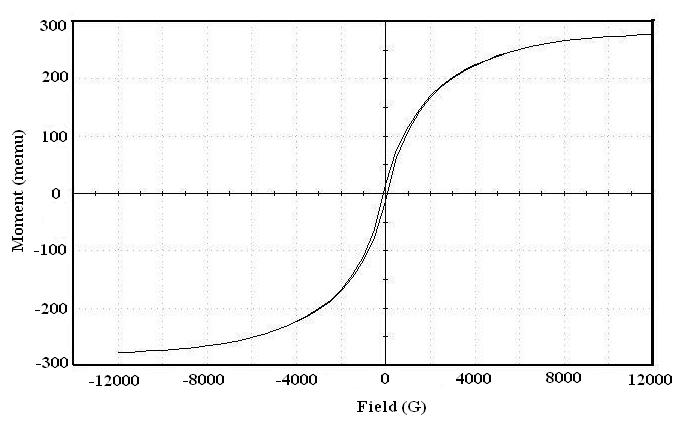 | Figure 6. Magnetic Studies of Ni-Mn-Ga particulate based polymer composites |
3.5. Damping Studies
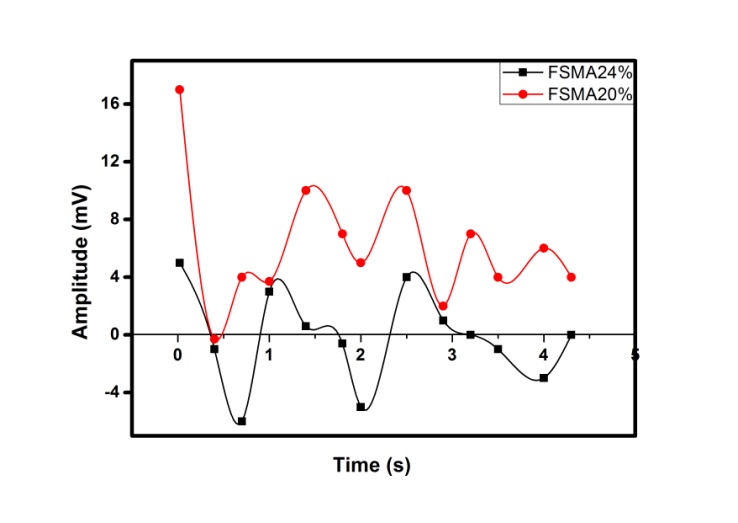 | Figure 7. The graph is plotted between the voltage and time parameters. The graph shows damping ability between the two closely optimized composites |
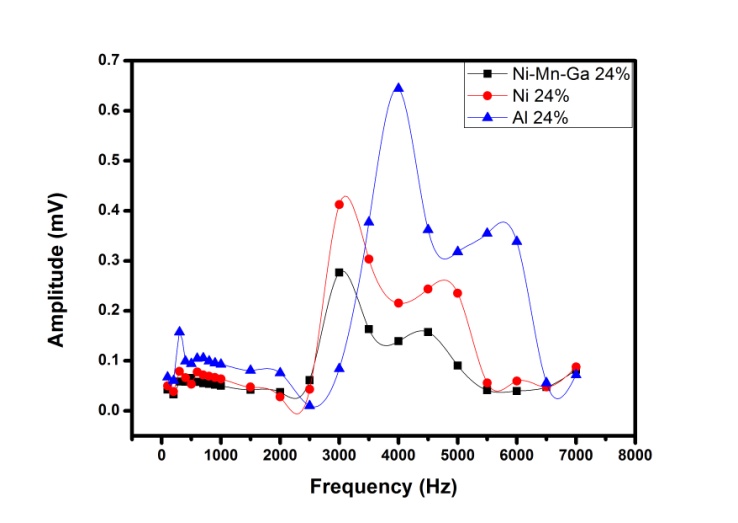 | Figure 8. Damping Studies of Different metal particulate based polymer composites |
4. Conclusions
- The polycrystalline Ni-Mn-Ga alloy is prepared and the room temperature martensite is confirmed. Then, the Ni-Mn-Ga/PU Polymer composite is fabricated to overcome the brittle nature of this active material. The magnetic particles are tried to align in the polymer matrix during curing process. The alignment of the particles is studies directly in the SEM results. The alignment may be formed either by optimizing the magnetic curing parameters or mechanical stress at particular direction. 24% volume fraction of the alloy in the polymer matrix is optimized through the damping studies. It is concluded that this polymer composite can be tailored to a very good absorbing material for the specific vibration damping applications.
ACKNOWLEDGMENTS
- MM thanks Dr. Robert C. O’Handley for his scholarly guidance and introducing him to the subject. The authors thank MIT Magnetic Materials group for their suggestions in composite preparation techniques and damping set up.
 Abstract
Abstract Reference
Reference Full-Text PDF
Full-Text PDF Full-Text HTML
Full-Text HTML